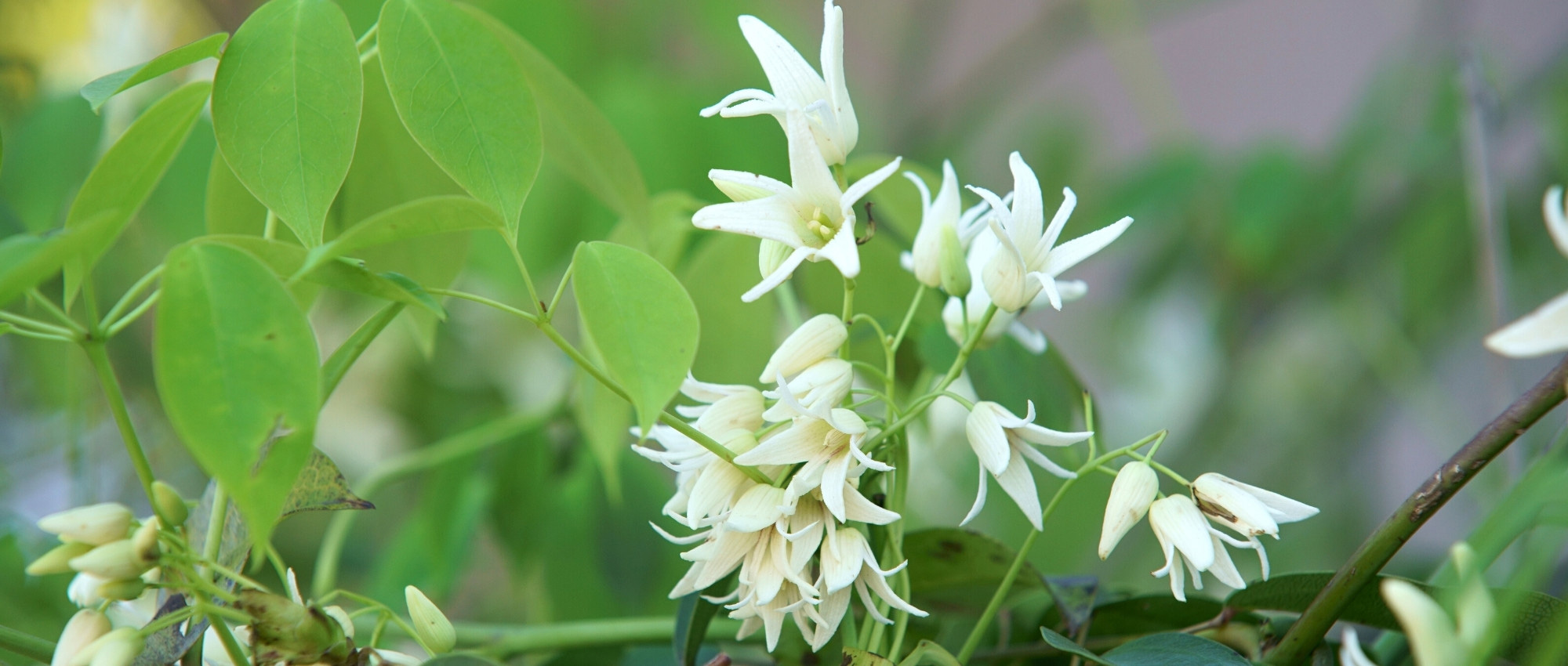
Stauntonia: planting, cultivating and maintaining
Contents
Stauntonia in a nutshell
- Stauntonia is a vigorous and evergreen climbing plant, decorative all year round
- Its beautiful dark green, palmate and glossy foliage is appreciated
- In spring, it produces small bell-shaped flowers, often pale pink, light yellow or purple, pleasantly scented
- It thrives in shade, in fresh, non-calcareous soil, but also adapts to pot cultivation
- It can climb over pergolas, arbors, fences and trees
- It is a robust plant, requiring little attention once established
A word from our expert
Stauntonia are beautiful, vigorous evergreen climbing plants native to the forests of East Asia. They form voluble stems that wrap around their support and bear beautiful, lush, finely cut palmate leaves. Their spring flowering is also appreciated, taking the form of small, fine, delicate bells, in a violet-white colour (Stauntonia hexaphylla) or dark purple (Stauntonia purpurea). They are still very little known and therefore rarely cultivated in gardens in France.
Stauntonia thrive in shade or partial shade, in good garden soil that is neither too dry nor too calcareous. They prefer humus-bearing, fertile, and rather acidic soils. These are vigorous plants that grow quickly. You can have them climb on a pergola, a garden shed, a tree, or a fence. They easily associate with other climbers such as clematis, honeysuckles, and akebias, creating a very natural scene in a shaded corner of the garden. Discover all our tips for successfully cultivating them in this guide.
Botany
Botanical data
- Latin name Stauntonia sp.
- Family Lardizabalaceae
- Common name Stauntonia
- Flowering April-May
- Height up to 10 m
- Exposure shade or partial shade
- Soil type cool, humus-bearing, rather acidic
- Hardiness down to -8 °C, even -10 °C
Stauntonia are woody, evergreen climbing plants native to East Asia (China, Japan, Korea, India, Myanmar, Taiwan, Vietnam…). They primarily grow in understorey areas, as well as at the forest edge and along riverbanks. There are 20 species. The most commonly cultivated is Stauntonia hexaphylla, which produces beautiful white or pink bell-shaped flowers in spring. It can tolerate temperatures down to -8, even -10 °C.
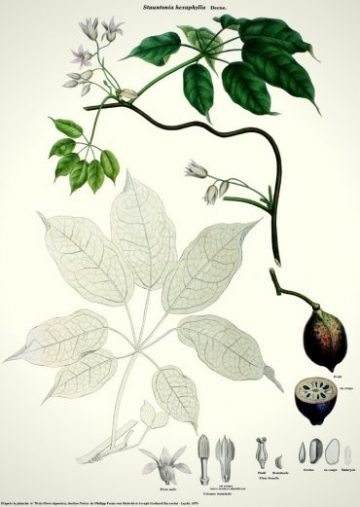
Stauntonia hexaphylla: botanical illustration
Stauntonia belong to the family Lardizabalaceae, which includes climbing plants and bushes from temperate to subtropical regions. This family also includes Akebia, Holboellia, and Decaisnea, which are also plants with beautiful ornamental qualities, but still rarely cultivated in gardens. Stauntonia is very close to Holboellia, and these two climbing plants are sometimes confused.
Stauntonia grows quickly and forms twining stems that wrap around their support on their own. Its stems can reach lengths of up to 10 metres.
Stauntonia flowers in spring, in April-May, and then offers clusters of 3 to 10 small, highly fragrant bell-shaped flowers borne in the axil of the leaves. They form slender, graceful, pendulous bells that measure about 4 cm long in Stauntonia hexaphylla. The flowers are described as campanulate because their shape resembles that of bellflowers. The flowers have six well-developed sepals that closely resemble petals. They have a waxy, fleshy texture and are very fine and elongated. Generally, the flowers do not have petals (more rarely, there may be six discreet petals).
The flowers of Stauntonia take on quite soft hues. The Stauntonia hexaphylla produces very beautiful pale pink flowers, S. obovata produces yellow flowers, while S. purpurea is distinguished by its dark purple flowers.

The flowering of Stauntonia hexaphylla, Stauntonia purpurea, and Stauntonia chinensis (photos: KENPEI / Shihchuan / HQ)
Stauntonia are generally monoecious, but some species are dioecious. Stauntonia hexaphylla bears both male and female flowers on the same plant. The female flowers are less colourful, lighter (greenish-white) than the male flowers, and generally have slightly wider sepals. The male flowers have six stamens that carry the pollen, while the female flowers have three carpels.
Stauntonia has evergreen foliage, which is interesting all year round. In spring, the new leaves that appear have a beautiful amber colour, which will later turn bluish-green over time. The leaves are palmate and are divided into 3 to 9 leaflets with entire margins. They are thick, leathery, and glossy. They resemble the foliage of Schefflera and measure between 7 and 15 cm long. The leaves are alternate, inserted one after the other on the stem, and are borne on a long petiole.

The foliage of Stauntonia hexaphylla: young leaves with their beautiful amber colour, detail of adult leaves, and the underside of the leaves (photos: igaguri_1 / KENPEI / Alpsdake)
With their lush, beautifully palmate foliage, Stauntonia are decorative in the garden all year round, even when not in flower. They have the advantage of providing presence even in winter.
Once pollinated, the female flowers of Stauntonia produce fruits in the shape of small sausages, which closely resemble those of Akebia and Holboellia. These fruits measure between 5 and 10 cm in length and are purple in colour. They are solitary or in pairs (rarely in threes). They contain a translucent white pulp and many brown seeds, which are released when the fruit reaches ripeness. These fruits are edible and are indeed prized in Japan.

The fruits of Stauntonia hexaphylla (photos: Adobe Stock / igaguri_1)
The main varieties of Stauntonia
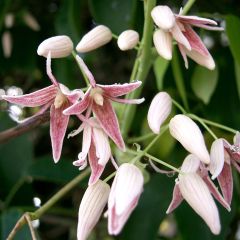
Stauntonia hexaphylla
- Flowering time May, June
- Height at maturity 10 m
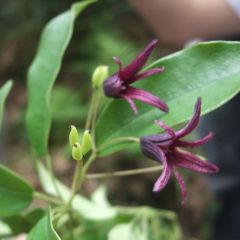
Stauntonia purpurea
- Flowering time May, June
- Height at maturity 8 m
Discover other Stauntonia
View all →Available in 1 sizes
Available in 1 sizes
Young plantation
Where to plant?
Stauntonia is found in the wild in Asia, in undergrowth and at the forest edge, it thrives in shade or partial shade. In northern France, it will accept planting in the sun. It appreciates cool, humus-rich and rather acidic soils. It can withstand temperatures down to -10 °C, but it is better to plant it in a location sheltered from cold winds.
Plant Stauntonia at the foot of a support on which it can climb: this could be, for example, a pergola, a gazebo, a garden shed, a wall, a fence, or a large tree.
Stauntonia also adapts to pot cultivation, which allows for easy sheltering during winter. This is a good solution for growing it in cold regions as well as on calcareous soils.
When to plant?
Plant Stauntonia in spring, as soon as the soil has warmed sufficiently and there is no longer a risk of frost.
How to plant?
For planting in the ground:
- Place the root ball in a basin filled with water to rehydrate it.
- Dig a planting hole two to three times the size of the root ball.
- Replace it with some soil mixed with well-decomposed compost.
- Remove the Stauntonia from its pot and plant it, well in the centre.
- Fill around by adding substrate and lightly compacting.
- Water generously.
- Guide the stems onto a support to help them cling.
You can also plant Stauntonia in a large container that you place on your terrace and bring in during winter to protect it from the cold.
For pot planting:
- Choose a pot of at least 40 cm in diameter and depth.
- Place a layer of gravel or clay balls at the bottom, about 5 cm thick, to improve drainage.
- Place a mixture of 1/3 potting soil, 1/3 garden soil, and 1/3 well-decomposed compost.
- Plant the Stauntonia in the pot, placing it well in the centre.
- Add some potting soil, then compact.
- You can add a small layer of mulch on the surface of the potting soil.
- Guide the branches onto their support to help them cling.
Place the pot in a shaded or partially shaded location.
Maintenance
Stauntonia requires little maintenance and has the advantage of being relatively resistant to diseases and pests. We recommend watering it during the first year, while it establishes itself and develops its root system, and subsequently during prolonged dry spells.
Similarly, it is advisable to support the stems of Stauntonia from time to time as it grows, helping them to wrap around their support.
It does not specifically need pruning, but you can shorten its stems if you wish to contain its growth a bit. The best time to do this is after flowering.
Feel free to add a layer of organic mulch at the base of the Stauntonia: this will help keep the soil cool for longer while limiting the growth of weeds.
Pot Cultivation:
If you are growing it in a pot, you will need to stay vigilant and water occasionally, as the substrate dries out much faster than in open ground. We recommend watering it once or twice a week from spring to autumn, and applying liquid fertiliser once a month. In winter, reduce watering slightly and stop fertiliser applications.
We also advise bringing Stauntonia into a frost-free greenhouse in autumn and taking it out again in spring, for example, to place it on your terrace.
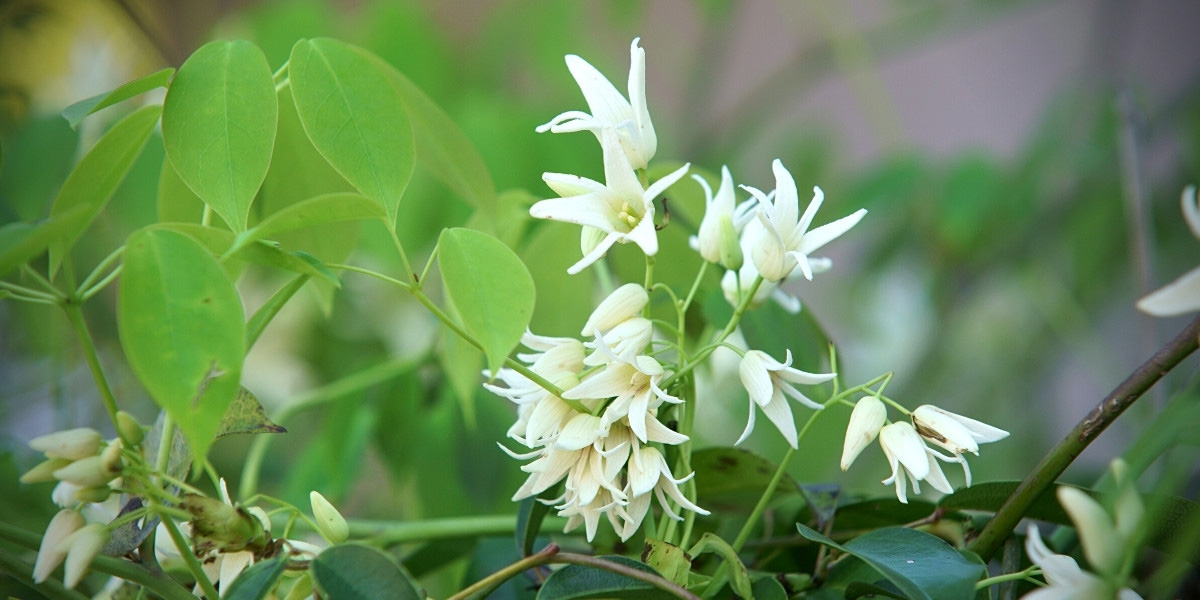
Stauntonia hexaphylla
Multiplication
Sowing
Stauntonia can be propagated by sowing. The ideal time is to collect the seeds in autumn, then place them in the refrigerator for two to three months (stratification), and then sow them.
- Start by preparing a pot with special sowing compost.
- Lightly firm it down and level the surface.
- Spread the seeds evenly on the surface.
- Cover them with a thin layer of substrate, and gently firm it down.
- Water with a fine spray.
- Place the pot in a sheltered location, in a bright spot but out of direct sunlight, ideally at a temperature between 15 and 20 °C.
- Ensure that the substrate remains slightly moist (but not waterlogged) until germination.
Then, be patient: the seeds may take several months to germinate. Transplant the young seedlings into individual pots as soon as they are large enough to handle. Keep them sheltered for their first winter, and wait until spring to plant them outdoors.
Propagation by Cuttings
Stauntonia can also be propagated by taking semi-woody stem cuttings in summer.
- Take a section of stem about 15 cm long, cutting just below a leaf.
- Remove the leaves from the base, leaving only a few at the top of the cutting. This limits evaporation and prevents the cutting from drying out.
- Optionally dip the base of the stem in plant hormone.
- Plant it in a pot filled with a mixture of compost and sand, previously moistened. The stem should be buried at least 3 or 4 cm deep.
- You can place the cutting in a humid environment by covering the pot with a cut bottle or a clear plastic bag to maintain a moisture-saturated atmosphere. However, it will need to be opened regularly for ventilation to prevent the cutting from rotting.
- Place the pot in a bright location, out of direct sunlight.
Ensure that the substrate remains slightly moist until germination.
Association
Stauntonia thrives in shaded situations and will easily find its place in a woodland garden. Its lush foliage will help create a wild and natural atmosphere! Plant it alongside perennials with decorative and generous foliage, such as hostas, ferns, hakonechloa, and heucheras (which come in a wide variety of shades). You can also bring brightness with the variegated and very graphic foliage of Fatshedera lizei ‘Variegata’, a hybrid between Fatsia and ivy! For flowering, consider the delicate small flowers of brunnera, epimediums, and Solomon’s seal.
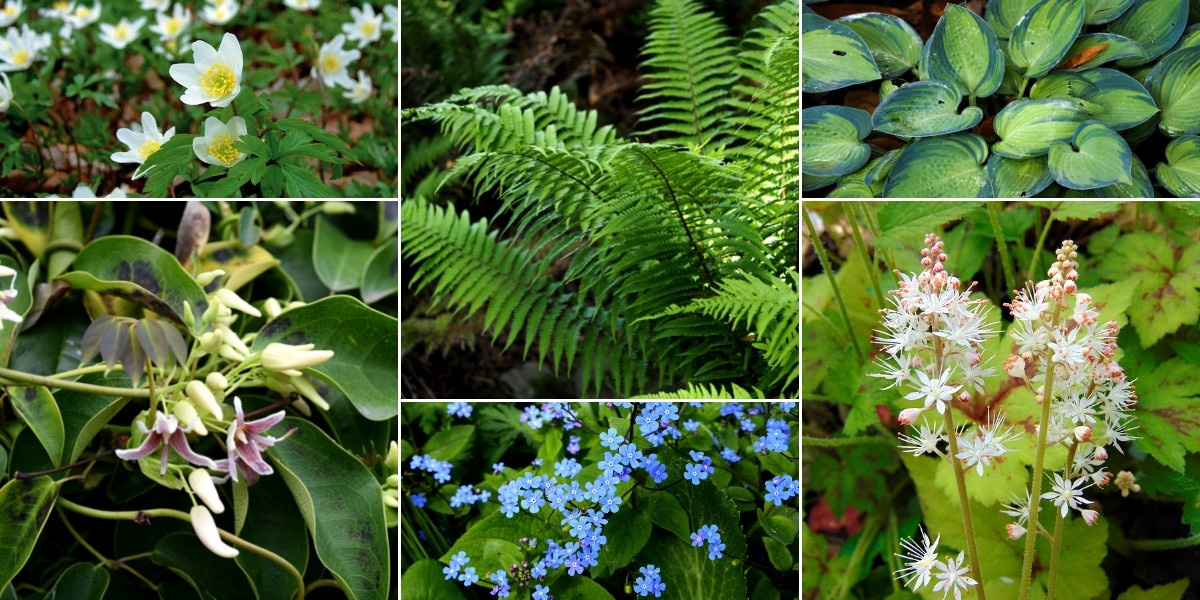 Stauntonia easily integrates into a woodland garden with a very natural style. Anemone nemorosa (photo Pandano), Dryopteris wallichiana, Hosta ‘June’, Stauntonia hexaphylla (photo Adobe Stock), Brunnera macrophylla, and Tiarella ‘Running Tiger’
Stauntonia easily integrates into a woodland garden with a very natural style. Anemone nemorosa (photo Pandano), Dryopteris wallichiana, Hosta ‘June’, Stauntonia hexaphylla (photo Adobe Stock), Brunnera macrophylla, and Tiarella ‘Running Tiger’As it prefers acidic soils, Stauntonia will easily accompany heather soil shrubs. Consider, for example, azaleas and rhododendrons, Japanese andromeda (Pieris japonica), Daphne, Leucothoe, and Skimmia. Moreover, most of these plants offer white or pink flowers, which is ideal for creating a harmonious bed with soft hues. Also discover Fothergilla gardenii, which produces beautiful feathery white spikes in spring.
Do not hesitate to associate Stauntonia with other climbing plants: clematis montana, honeysuckle, Virginia creeper, ivy… Also consider Holboellia and Akebia, with which it is very closely related!
Finally, it can also be part of a zen garden or a Japanese-style scene. Create a simple and uncluttered garden, conducive to meditation, by pairing it with the graphic foliage of Japanese maples, hostas, Hakonechloa macra, Nandina domestica… You can surround the garden with a border of bamboo to create a closed and intimate space. Also integrate some ferns: for example, Coniogramme emeiensis, Cyrtomium falcatum, or Athyrium niponicum.
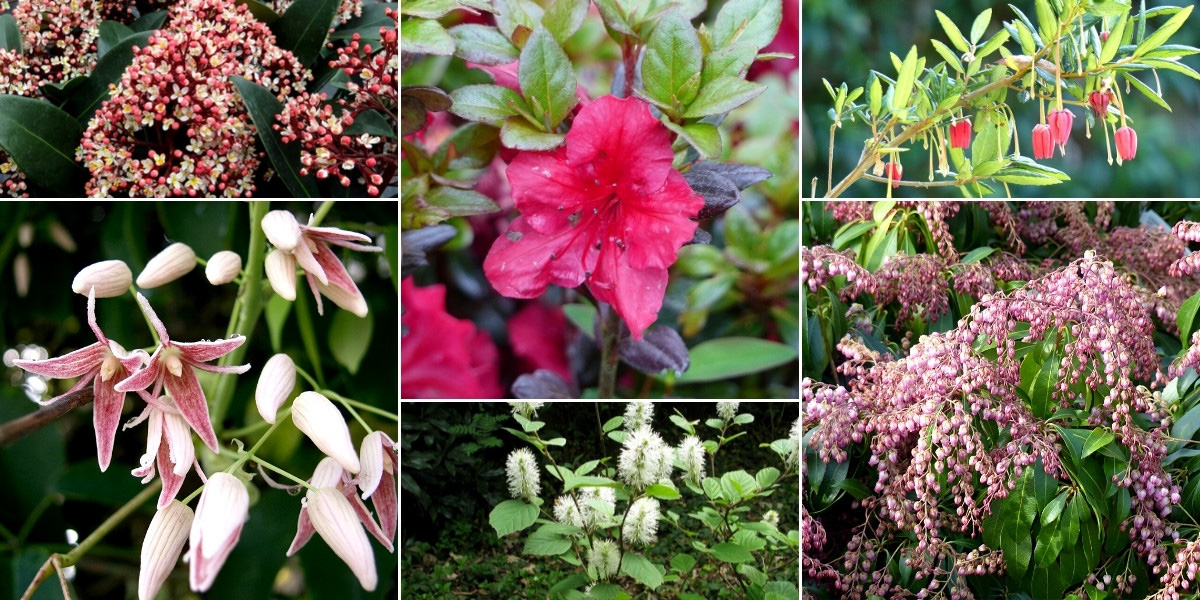 Feel free to associate Stauntonia with heather soil shrubs. Skimmia japonica ‘Rubella’, Japanese azalea ‘Johanna’, Crinodendron hookerianum, Stauntonia hexaphylla (photo KENPEI), Fothergilla major (photo peganum), and Pieris japonica ‘Katsura’
Feel free to associate Stauntonia with heather soil shrubs. Skimmia japonica ‘Rubella’, Japanese azalea ‘Johanna’, Crinodendron hookerianum, Stauntonia hexaphylla (photo KENPEI), Fothergilla major (photo peganum), and Pieris japonica ‘Katsura’→ More association ideas with Stauntonia in our advice sheet!
Useful resources
- Discover our range of Stauntonia
- Browse our guide to cultivating Stauntonia in pots
- Also discover Holboellia and Akebia, other climbing plants that are very close to Stauntonia
- Subscribe!
- Contents

































Comments